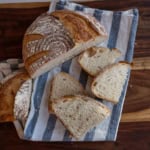No Knead Sourdough Bread
This no-knead sourdough bread recipe is the perfect way to enjoy freshly baked bread—it's an easy beginner's recipe! Why? Because there is no need to knead!
Servings: 1 loaf
Ingredients
- 1/3 cup bubbly active sourdough starter (75 g)
- 1 1/4 cups water (300 g)
- 4 cups bread flour (500 g)
- 2 teaspoons fine sea salt (10 g)
Instructions
- Feed your starter 4-12 hours before you plan to use it.
- In a medium bowl, combine the active starter with water, stirring well with a fork.
- Add the flour and salt. Mix with a fork until the ingredients are combined. The dough will look rough and sticky, which is perfectly fine.
- Let the dough rest for 10 minutes and then stir it one more time. There should be no dry spots and it should look like traditional bread dough.
- After the initial rest, cover the bowl again and let the dough ferment for 8-18 hours at room temperature. This is the bulk rise, allowing the dough to develop flavor and structure. An overnight rise is generally the easiest timer for most bakers.
- Gently transfer the dough onto a lightly floured surface. Shape the dough by tucking the edges into the center, forming a tight ball. Let the dough rest for 5-10 minutes.
- Dust a proofing basket or an 8-inch mixing bowl (lined with a floured kitchen towel or generously coated with cooking spray and flour) to prevent sticking. Place the dough ball, smooth side down, into the basket or bowl. Cover with a damp towel.
- Let the dough rest for 1-4 hours at room temperature until it spreads slightly and looks puffy.
- Preheat your oven to 450°F (230°C). Carefully turn the dough out onto a piece of parchment paper, score the top, and transfer to a preheated Dutch oven with the lid on.
- Bake covered for 40 minutes, then remove the lid and bake for another 10-15 minutes until dark brown and hollow-sounding when tapped.
- Remove the bread from the oven, transfer to a wire rack, and let cool for at least 1 hour before slicing. Enjoy the bread fresh, or use leftovers for toast and sandwiches!
Notes
- I highly recommend using bread flour for this recipe instead of swapping it out for all-purpose. Because we are not building up the gluten by stretching and folding, it’s better to start with flour that has more gluten; that’s bread flour! You’ll get a nicer loaf by using it.
- I’m sourdough obsessed and wrote a whole cookbook about it! It has step-by-step photos of this recipe if that’s helpful. You can buy a digital or hardcover copy of the sourdough cookbook here.
- If the bottom crust is too dark, try lowering your oven temperature by 25 degrees.
- After I mix up my dough, I refresh my starter by feeding it. I keep 25 grams of the leftover starter and mix it with 50 grams of water and 50 grams of flour by weight. I leave it on the counter if I’m baking tomorrow. If I’m not baking again the next day, I let it rest at room temperature for a few hours and then store it, covered, in the fridge until I’m ready to bake again.
Nutrition
Calories: 1805kcal | Carbohydrates: 363g | Protein: 60g | Fat: 8g | Saturated Fat: 1g | Polyunsaturated Fat: 4g | Monounsaturated Fat: 1g | Sodium: 4676mg | Potassium: 501mg | Fiber: 12g | Sugar: 2g | Vitamin A: 10IU | Calcium: 87mg | Iron: 5mg
QR code
Scan this QR code with your phone's camera to view this recipe on your mobile device.
